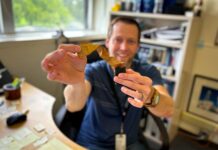
Researchers at Columbia Engineering have demonstrated, for the first time, a chip-based dual-comb spectrometer in the mid-infrared range, that requires no moving parts and can acquire spectra in less than 2 microseconds. The system, which consists of two mutually coherent, low-noise, microresonator-based frequency combs spanning 2600 nm to 4100 nm, could lead to the development of a spectroscopy lab-on-a-chip for real-time sensing on the nanosecond timescale.
Creating a spectroscopic sensing device on a chip that can realize real-time, high-throughput detection of trace molecules has been challenging. A few months ago, teams led by Gaeta and Michal Lipson, Higgins Professor of Electrical Engineering, were the first to miniaturize dual-frequency combs by putting two frequency comb generators on a single millimeter-sized chip. They have been working on broadening the frequency span of the dual combs, and on increasing the resolution of the spectrometer by tuning the lines of the comb.
In this current study, the researchers focused on the mid-infrared (mid-IR) range, which, because its strong molecular absorption is typically 10 to 1,000 times greater than those in the visible or near-infrared, is ideal for detecting trace molecules. The mid-IR range effectively covers the “fingerprint” of many molecules.
Read more: Chip-scale broadband optical system that can sense molecules
thumbnail courtesy of phys.org


















